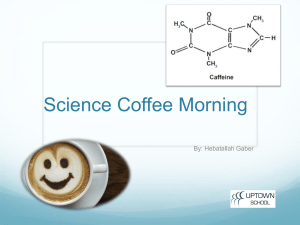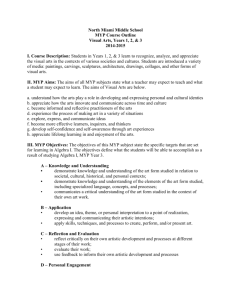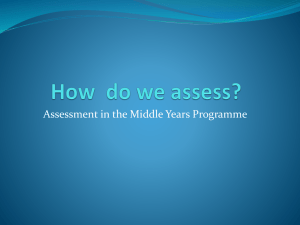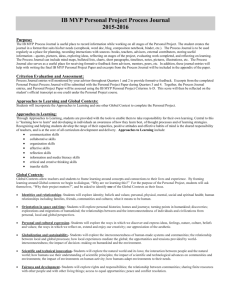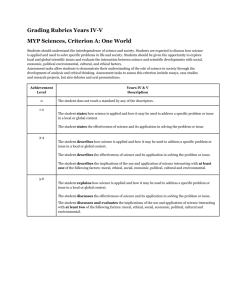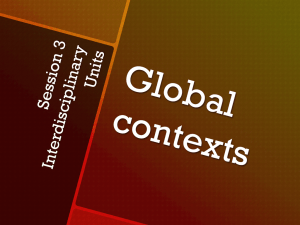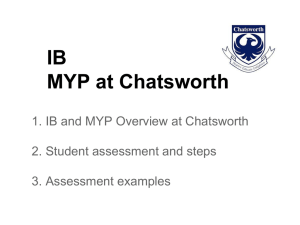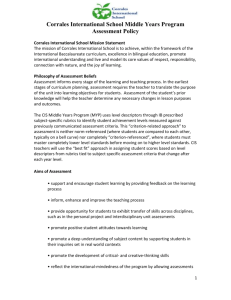Assessments for Parents Presentation PowerPoint
advertisement
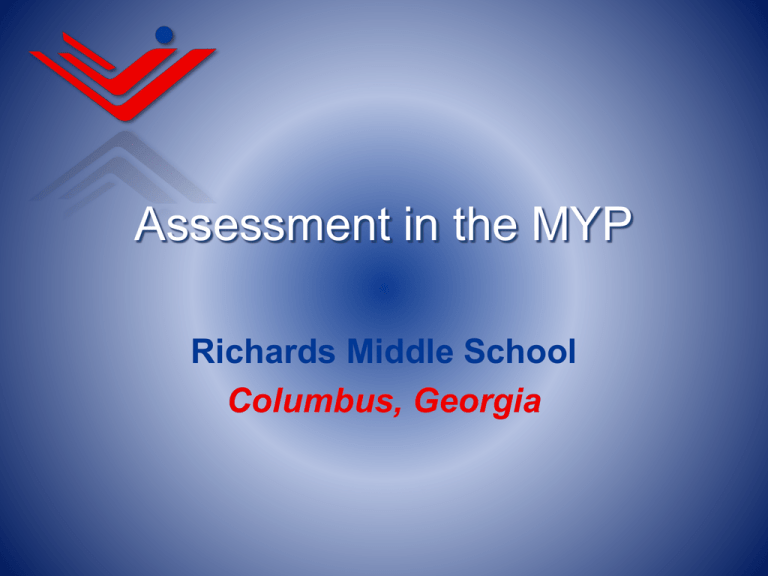
Assessment in the MYP Richards Middle School Columbus, Georgia What is assessment? • “the evaluation of the ability of a student” • usually using an assessment task Examples: • • • • Test Essay Presentation Experiment • • • • Experiment Report Artwork Performance Product 2 Internal / Continuous MYP Assessment can be described as internal and continuous. Internal Continuous Tasks, strategies and tools are designed, developed and applied by teachers. Assessment in the MYP takes places throughout the programme. Not just at the end of the programme. 3 The purposes of Assessment Assessment in the MYP aims to: • • • • • • • support and encourage student learning by providing feedback on the learning process inform, enhance and improve the teaching process promote positive student attitudes towards learning promote a deep understanding of subject content by supporting students in their enquiries set in real world contexts using areas of interaction promote the development of higher-order cognitive skills by providing rigorous final objectives that value these skills reflect the international-mindedness of the programme by allowing for assessments to be set in a variety of cultural and linguistic contexts support the holistic nature of the programme by including in its model principles that take account of the development of the whole student 4 The purposes of Assessment Assessments can be of two forms, based on how they are used. These are formative and summative. •Formative Assessment – ongoing assessment aimed at providing information to guide teaching and improve student performance •Summative Assessment – a culminating assessment for a unit, term or course of study, providing information on a student’s achievement level against specific objectives 5 Student Learning Most important purpose – support student learning For the student: •gathering and analysis of information •feedback to students •provide a basis for practice For the teacher: •identify student learning needs 6 Assessment Criteria Science A. One world 6 B. Communication in science 6 C. Knowledge & understanding of science 6 D. Scientific inquiry E. Processing data F. Attitudes in science 6 6 6 7 Assessment Criteria A. Knowledge and understanding B. Application Art 8 10 C. Reflection and evaluation 8 D. Personal Engagement 8 8 Levels of Achievement • Assessment in the MYP is criterion-related • Each criterion is split into various levels of achievement – normally in bands • Each band described in terms of general statements called level descriptors • Levels 1 & 2 on first band, 3 & 4 on second band, etc. Level 0 is available. • Teacher determines the best fit 9 Level Grade Descriptor Levels of Achievement 0 The student does not reach a standard described by any of the descriptors given below. 1–2 The student attempts to communicate scientific information using some scientific language. The student presents some of the information in an appropriate form using some symbolic or visual representation when appropriate. The student attempts to acknowledge sources of information but this is inaccurate. 3–4 The student communicates scientific information using scientific language. The student presents most of the information appropriately using symbolic and/or visual representation according to the task. The student acknowledges sources of information with occasional errors. 5–6 The student communicates scientific information effectively using scientific language correctly. The student presents all the information appropriately using symbolic and/or visual representation accurately according to the task. The student acknowledges sources of information appropriately. 10 Interim / Modified • The subject-guide tables are for students near the end of the course. • The IB provides interim objectives for years 1 and 3 of the programme (grades 6 and 8) • The school produces modified criteria that match the interim objectives 11 Assessment Tasks Assessment Tasks … • must be appropriate – they must cover at least one of the assessment criteria – suitable task for the skill – suitable for the students • must allow access to all levels 12 Rubrics • Rubric means assessment table • The published criteria and the interim criteria are holistic rubrics • Task-specific clarifications can be developed from the holistic rubrics 13 Final Assessment • Each criteria (in each subject) should be assessed several times over the semester or year • The teacher uses professional judgement to determine the final level of the student at that point in time • NOT an arithmetical average • NO fractions – whole numbers only 14 The final subject grade • All of the criterion levels for that subject are added together Science Grade Boundaries 1 0–5 2 6 – 11 • The total is converted to a 1 – 7 grade using a table 3 12 – 18 4 19 – 24 5 25 – 28 6 29 – 32 7 33 – 36 15 Standardisation / Moderation • Standardisation - Teachers of each subject meet together and compare assessed work to ensure they are giving the same grades to the same work 16 IB Report Cards • One given at the at the end of the year • IB grades based on a minimum assessment of two per criterion (per objective) • Grades given per task on an IB Assessment Rubric (grade sheet) • All IB grades will be calibrated per content area based on the criterion grades earned, student progress witnessed and teacher observation 17 Criterion A: Knowledge and Understanding Achievement Level Level Descriptor 0 The student does not reach a standard described by any of the descriptors given below. 1-2 The student attempts to make deductions when solving simple problems in familiar contexts. 3-4 The student sometimes makes appropriate deductions when solving simple and more complex problems in familiar contexts. 5-6 The student generally makes appropriate deductions when solving challenging problems in a variety of familiar contexts. 7-8 The student consistently makes appropriate deductions when solving challenging problems in a variety of contexts including unfamiliar situations. Formatted Descriptors 18 RICHARDS MIDDLE SCHOOL 2013-2014 IBMYP Report Card Parents, The Middle Years Program of the International Baccalaureate uses this assessment model to evaluate student achievement. These assessments are based on student work evaluated with the IB Criterion. Please review the descriptors to see how your child has performed. Teachers have placed the IB Grade earned in their subject areas on the chart below. Name _____________________________________ Homeroom _____________ Year _______ Grade Descriptors Grade 1 Minimal achievement in terms of objectives Grade 2 Very limited achievement against all objectives. The student has difficulty in understanding the required knowledge and skills, and is unable to apply them fully in normal situations, even with support. Grade 3 Limited achievement against most of the objectives, or clear difficulties in some areas. The student demonstrates limited understanding of the required knowledge and skills, and the ability to apply them effectively in normal situations with support. Grade 4 A good general understanding of the required knowledge and skills, and the ability to apply them effectively in normal situations. There is occasional evidence of the skills of analysis, synthesis and evaluation. Grade 5 A consistent and thorough understanding of the required knowledge and skills, and the ability to apply them in a wide variety of situations. There is consistent evidence of analysis, synthesis and evaluation where appropriate and occasionally demonstrates originality and insight. Grade 6 A consistent and thorough understanding of the required knowledge and skills, and the ability to apply the in a wide variety of situations. There is consistent evidence of analysis, synthesis and evaluation where appropriate. The student generally demonstrates originality and insight. Grade 7 A consistent and thorough understanding of the required knowledge and skills, and the ability to apply them almost faultlessly in a wide variety of situations. There is consistent evidence of analysis, synthesis and evaluation where appropriate. The student consistently demonstrates originality and insight and always produces work of high quality. 19 Course Teacher Grade Language A Language B (Spanish) Humanities Science Math Arts (Drama, Band, Orch, Chorus) P.E. Technology/Connections(Visual Arts, Computers, Expl. In Tech.) Final Grade_______ 20 In Conclusion • The MYP approach to assessment recognizes the importance of assessing the process of learning as well as the products of learning, and aims to integrate and support both. • The traditional report card reflects the final grade in each subject based on the grades earned on assignments, projects and tests. • The IBMYP report card combines these IB earned achievement grades for specific activities as well as the demonstrated process of learning and their applications. • The two report cards are separate and measure different things, so the results in one do not effect or influence the other. 21
